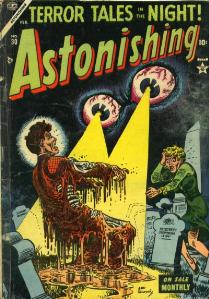 Ah, comic books.
Ah, comic books.As a sweaty awkward teenager I read many MANY comic books. Though I no longer read them with any frequency, there is something wonderful about comic books for me. Morality was clearly defined for the most part, bad guys were BAD, and good guys tried to do right.
The "Golden Age" comic books are of particular interest to me. Such books were published from the 1930s-late 1940s/early 1950s, and were where the Superhero genre began. In these comics, heroes battled weird monsters, ghosts, zombies, giant robots, mad scientists, Nazis and the Japanese. They fought with two-fisted justice and won because of their guts, grit and ideals (and powers).
 This isn't to say that Golden Age comics were necessarily "kid stuff" by modern standards. Before the coming of The Comics Code Authority in 1954, comic books were enormously varied in content. Supernatural Horror and stories involving brutal murders were quite common (and very graphic).
This isn't to say that Golden Age comics were necessarily "kid stuff" by modern standards. Before the coming of The Comics Code Authority in 1954, comic books were enormously varied in content. Supernatural Horror and stories involving brutal murders were quite common (and very graphic).Even superhero comics could be brutal by todays standards. Superman in his Golden Age persona had no problem killing enemy soldiers and particularly nasty criminal types. Batman was also responsible for the death of several gangster-type baddies. Of course America was in the Great Depression, and racketeers were seen as satanic villains. So there wasnt much public outcry to comics that fantacised about their doom.
And people think superheroes always had to save everybody...
Superhero Role Playing Games
Role Playing Games that feature "Supers" are a hard sell. As it is very VERY easy for players to get stuck on the characters powers rather then focussing on what makes the character a HERO. To make a super character, you have to determine from the get-go why this guy does the hero thing. Is it vengeance, an ingrained sense of justice, a duty passed to you by your home planet? After that is determined, you can create the other bits and push this motivation into everything that you do or say.
Game systems for this sort of thing are tricky. Because of the sheer number of potential powers, most super game systems are incredibly complex to the point of gross tedium. Still, some mutant math majors out there like these systems, though I am not one of them. I prefer "rules light" game systems for superhero games, ones that allow you to get to the action, and enjoy the world in which the character lives. I recommend the following game settings and systems:
Aberrant (White Wolf): A well thought out setting and using a version of the Storyteller system. Fun and well thought out, it features one of the best system for creating potentially unstable superheroes much like the X-Men and their many mutant friends and foes. Now out of print, but can be found at RPGnow.com.
Heroes Unlimited (Palladium): A bit clunky mechanic wise, but alot of fun.
Four Color (Homebrew/Fan Made): This is my favorite. Lightweight and easy to understand. It being free, AND only having 14 pages in the main Players Guide is a big bonus.
Also, for those who are artistically challenged. Check out the Hero Machine. Its an online character art generator for those wishing to have a kewl character portrait to accompany their hero (or villain) character!
Below is a trailer for an interesting animated movie.
It depicts a future setting in which the old villain Ultron defeated the superheroes of the world. For those who dont know, Ultron is an evil robot whose "skin" is made from Adamantium, the unbreakable matal that Wolverines skeletons and claws are made from. This makes him REALLY tough and strong, though in the past heroes have defeated him by destroying his internal components by sending a shrunken hero in through his mouth. Why a robot needs a mouth is apparently a question we are not supposed to ask...






